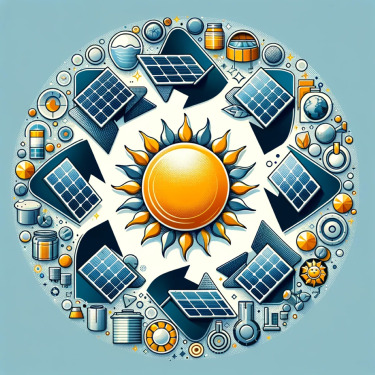Peters I.M., Hauch, J., Brabec C.J.
Joule, 2024
As the world races toward carbon neutrality, the photovoltaic (PV) industry is experiencing unprecedented growth, with projections indicating a need for multi-10-terawatt capacity by mid-century. This expansion underscores the critical role of PV in global energy transition while simultaneously emphasizing the need to formulate effective strategies for material demand management and recycling. The study reveals the critical role of circular recycling in supporting the sustained rapid growth of PV production. Circular recycling is particularly relevant, given the finite availability of essential resources such as silver and the constraints in polymer production capacities. We argue that circular recycling is a strategic imperative for the PV industry to sustain its growth while minimizing the strain on global resource pools. For instance, silver, crucial for PV module manufacturing, faces competition from other markets, highlighting the need for its reduction or replacement. Similarly, the vast demand for glass by the PV industry could potentially overwhelm alternative markets, making circular recycling a vital solution. Moreover, the study points out that recycling materials like silicon, aluminum, and copper is essential for economic viability, especially if silver is replaced. This circular approach aligns with the broader objectives of a circular economy, where cradle-to-cradle recycling integrates with other industries’ needs and sustainability goals. Thus, this study not only maps the current landscape of PV material demand and recycling but also charts a course toward a more sustainable and economically viable future for the PV industry.

Peters I.M., Hauch, J., Brabec C.J.
Joule, 2024
As the world races toward carbon neutrality, the photovoltaic (PV) industry is experiencing unprecedented growth, with projections indicating a need for multi-10-terawatt capacity by mid-century. This expansion underscores the critical role of PV in global energy transition while simultaneously emphasizing the need to formulate effective strategies for material demand management and recycling. The study reveals the critical role of circular recycling in supporting the sustained rapid growth of PV production. Circular recycling is particularly relevant, given the finite availability of essential resources such as silver and the constraints in polymer production capacities. We argue that circular recycling is a strategic imperative for the PV industry to sustain its growth while minimizing the strain on global resource pools. For instance, silver, crucial for PV module manufacturing, faces competition from other markets, highlighting the need for its reduction or replacement. Similarly, the vast demand for glass by the PV industry could potentially overwhelm alternative markets, making circular recycling a vital solution. Moreover, the study points out that recycling materials like silicon, aluminum, and copper is essential for economic viability, especially if silver is replaced. This circular approach aligns with the broader objectives of a circular economy, where cradle-to-cradle recycling integrates with other industries’ needs and sustainability goals. Thus, this study not only maps the current landscape of PV material demand and recycling but also charts a course toward a more sustainable and economically viable future for the PV industry.